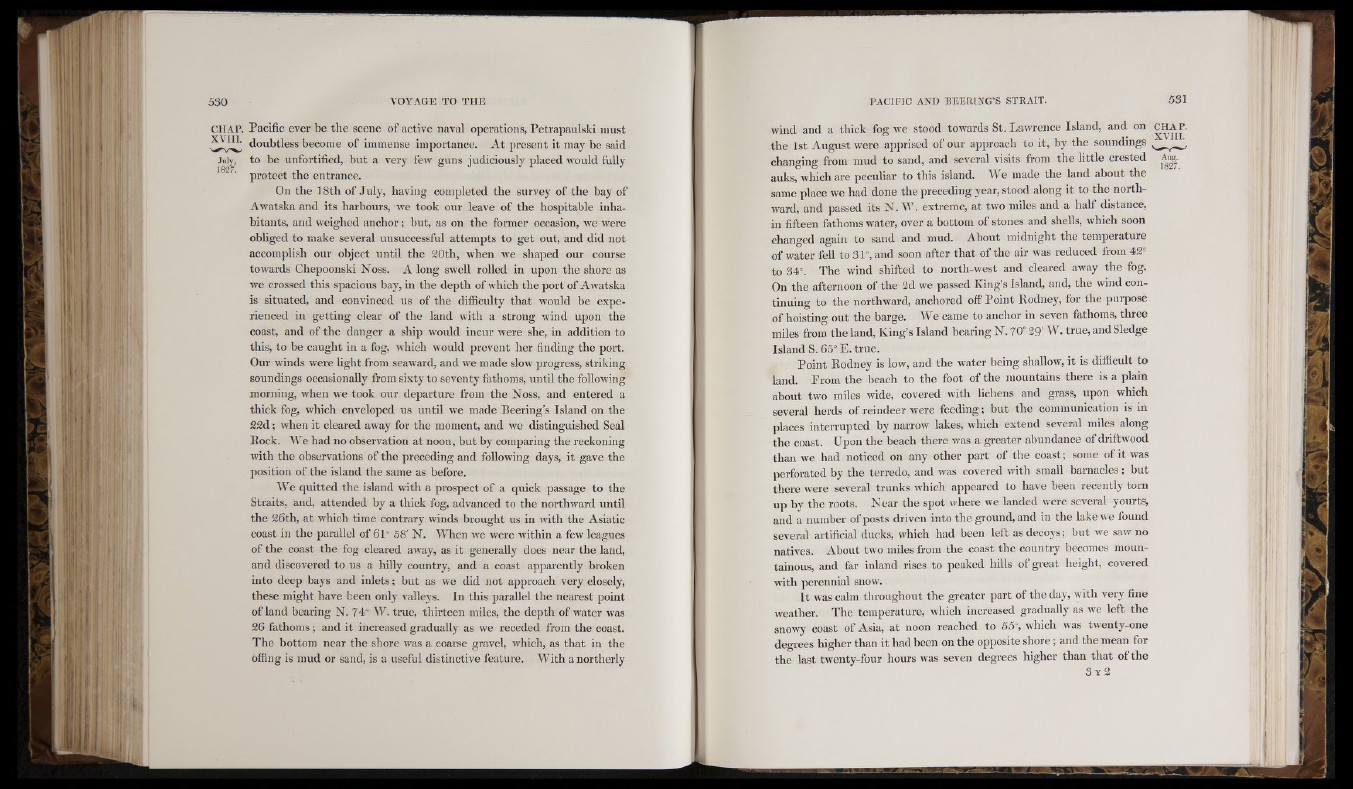
C H A P . Pacific ever be the scene of active naval operations, Petrapaulski must
m m doubtless become of immense importance. At present it may be said
July, to be unfortified, but a very few guns judiciously placed would fully
'■ protect the entrance.
On the 18th of .July, having completed the survey of the bay of
Awatska and its harbours, we took our leave of the hospitable inhabitants,
and weighed anchor; but, as on the former occasion, we were
obliged to make several unsuccessful attempts to get out, and did not
accomplish our object until the 20th, when we shaped our course
towards Chepoonski Noss. A long swell rolled in upon the shore as
we crossed this spacious bay, in the depth of which the port of Awatska
is situated, and convinced us of the difficulty that would be experienced
in getting clear of the land with a strong wind upon the
coast, and of the danger a ship would incur were she, in addition to
this, to be caught in a fog, which would prevent her finding the port.
Our winds were light from seaward, and w'e made slow progress, striking
soundings occasionally from sixty to seventy fathoms, until the following
morning, when we took our departure from the Noss, and entered a
thick fog, which enveloped us until we made Beering’s Island on the
2 2 d ; when it cleared away for the moment, and we distinguished Seal
Eock. We had no observation at noon, but by comparing the reckoning
with the observations o fth e preceding and following days, it gave the
position of the island the same as before.
We quitted the island with a prospect of a quick passage to the
Straits, and, attended by a thick fog, advanced to the northward until
the 26th, at which time contrary winds brought us in with the Asiatic
coast in the parallel of 61° 58' N . When we were within a few leagues
of the coast the fog cleared away, as it generally does near the land,
and discovered to us a hilly country, and a coast apparently broken
into deep bays and inlets; but as we did not approach very closely,
these might have been only valleys. In this parallel the nearest point
of land bearing N. 74° W. true, thirteen miles, the depth of water was
26 fathoms; and it increased gradually as we receded from the coast.
The bottom near the shore w'as a coarse gravel, which, as that in the
offing is mud or sand, is a useful distinctive feature. With a northerly
wind and a thick fog we stood towards St. Lawrence Island, and on CHAJ’.
the 1st August were apprised of our approacli to it, by the soundings
changing from mud to sand, and several visits from the little crested
Aug.
1827.
auks, which are peculiar to this island. W e made the land about the
same place we had done the preceding year, stood along it to the northward,
and passed its N.VA'. extreme, at two miles and a half distance,
in fifteen fathoms water, over a bottom of stones and shells, which soon
changed again to sand and mud. About midnight the temperature
of water fell to 31°, and soon after that of the air was reduced from 42°
to 84°. The wind shifted to north-west and cleared away the fog.
On the afternoon of the 2d we passed King’s Island, and, the wind continuing
to the northward, anchored off Point Rodney, for the purpose
of hoisting out the barge. We came to anchor in seven fathoms, three
miles from the land, King’s Island bearing N. 70° 29' W. true, and Sledge
Island S. 65° E. true.
Point Rodney is low, and the water being shallow, it is difficult to
land. From the beach to the foot of the mountains there is a plain
about two miles wide, covered with lichens and grass, upon which
several herds of reindeer were feeding; but the communication is in
places interrupted by narrow lakes, which extend several miles along
the coast. Upon the beach there was a greater abundance of driftwood
than we had noticed on any other part of the coast; some o fit was
perforated by the tcrredo, and was covered with small barnacles ; but
there were several trunks which appeared to have been recently torn
up by the roots. Near the spot where we landed were several yourts,
and a number of posts driven into the ground, and in the lake we found
several artificial ducks, which had been left as decoys; but we saw no
natives. About two miles from the coast the country becomes mountainous,
and far inland rises to peaked hills of great heiglit, covered
with perennial snow.
It was calm throughout the greater part of the day, with very fine
weather. The temperature, which increased gradually as we left the
snowy coast of Asia, at noon reached to 55°, which was twenty-one
degrees higher than it had been on the opposite shore; and the mean for
the last twenty-four hours was seven degrees higher than that ofthe
3 y 2